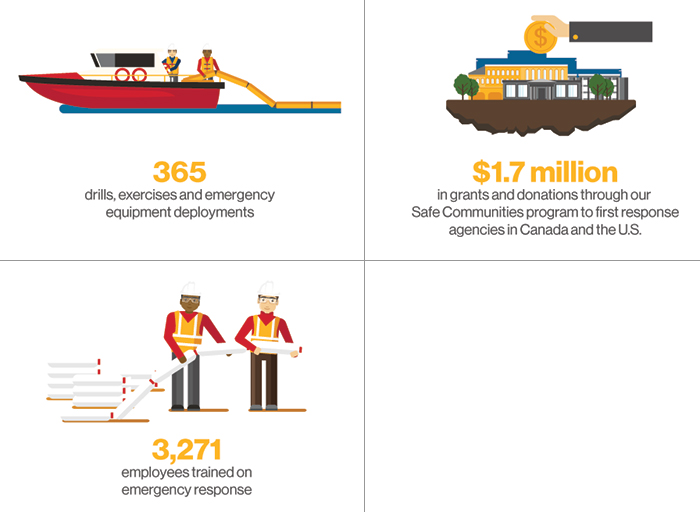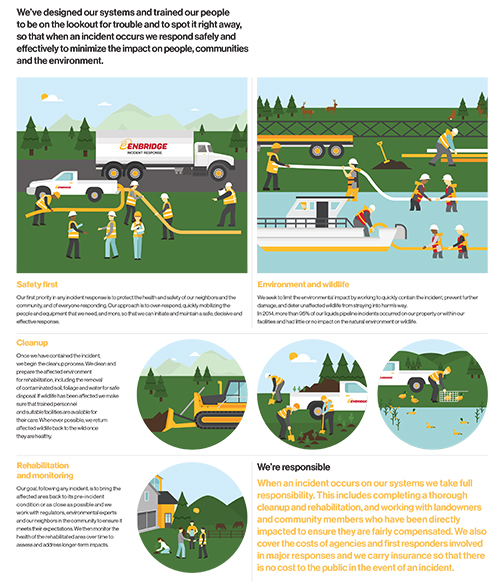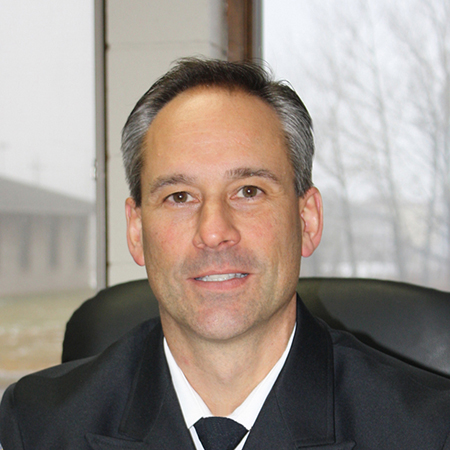Emergency Preparedness & Response
Overview
In the event of an incident, we are prepared.
On our Path to Zero, we believe that all incidents can be prevented and that no release is acceptable. However, if an incident does occur, we are ready to respond safely and effectively in partnership with local first-response agencies and regional and national authorities.
We maintain strong emergency preparedness and response systems. We regularly test and continuously improve our emergency response tactics and plans with local first responders and emergency management and government officials. We regularly review our emergency management programs across our businesses to ensure that they are functioning as intended and identify opportunities for continual improvement. In the event of an incident, our employees and contractors are well trained and equipped to ensure a safe, rapid and effective response.
5 performance objectives:
- Ensuring our emergency response plans are current
- Training our emergency response teams
- Maintaining and strengthening our Enbridge Enterprise Emergency Response Team
- Regularly exercising our emergency response teams
- Working with key industry and emergency response associations
2017 Highlights

Management Approach
Emergency preparedness and response requires a systematic approach to ensure that all hazards are identified and anticipated so that a response is rapid, effective and protective of workers, the public and the environment. An overview of our approach to emergency management programs is available here.
Enbridge has an incident management organizational structure that, depending on the nature and magnitude of the incident, can cover all levels of the organization―from the front-line worker to the executive leadership team—and can be activated immediately following an incident.
The Enbridge emergency management programs guide our efforts to be prepared for and respond to emergencies. These Emergency Management Programs are implemented at all of our business units, regularly reviewed by management and personnel, and periodically audited to ensure their continual improvement and proper functioning.
2017 Performance
Training Our Emergency Response Teams
We have defined roles and responsibilities for those who would be involved in emergencies. The training that these individuals receive aligns with the role they will fill during an emergency and the hazards associated with their area of operation.
As part of our emergency response training, we use the Incident Command System (ICS), a federally-recognized emergency response methodology applied across North America by military, first-response agencies, and local, state, provincial and federal governments. ICS enables our employees and contractors to react quickly and efficiently to the emerging issues and challenges that are inevitable in a real-life emergency response.
In addition to ICS training, we also design emergency response training programs that meet the specific needs of each of our business segments, and which reflect their specific risks and types of emergency situations. For example, operations staff in our liquids pipelines business segment may complete booming, skimming and boat-handling courses.
By the end of 2017, we had provided emergency response training to 3,271 of our employees and direct contractors. The training requirements are unique to each business segment based on the hazards that may be encountered during an emergency.
By the end of 2017:
In March 2017, in Fort Worth, Texas, about 150 members of the Enbridge team took part in a five-day training seminar called ICS School 2017—and gained a greater appreciation of the Incident Command System, a standardized emergency response system used across North America by military, first response agencies and government. Read the story.
Enbridge Gas Distribution's (EGD) Technology and Operations Centre (TOC) in Markham, Ontario, opened in October 2012 and is a leading North American gas distribution training facility – both technically and environmentally.
Inside its 105,000 square foot main building, the centre offers practical, hands-on learning as well as traditional classroom environments. Outside, the centre’s defining feature is a streetscape where workers are trained on real-life, adaptable situations in a fully functioning distribution system. It includes infrastructure common in an urban community such as full-sized roads and buildings that represent different residential, commercial and industrial premises. Compressed air is used to simulate natural gas and offers a controlled, safe environment for training Enbridge employees and contractors.
In 2017, the TOC conducted more than 5,000 technical training sessions and ensured 9,215 Environment Health and Safety (EHS) and Operator Qualification (OQ) certifications were completed by employees.
Maintaining and Strengthening our Enbridge Enterprise Emergency Response Team
Our Enbridge Enterprise Emergency Response Team (E3RT) is a cross-business-segment group trained to respond to large-scale events in Canada and the U.S. that require more resources than one of our operating regions or business segments alone could provide. The E3RT members are trained in ICS (please see above for a description of ICS). In 2017, the E3RT held a five-day training seminar at which about 120 Enbridge employees further strengthened their ICS skills.
Regularly Exercising Our Emergency Response Teams
To keep our employees and contractors prepared, we stage both discussion-based and operations-based exercises across the company―everything from seminars, workshops and tabletop exercises, to full-scale exercises involving our employees and contractors, local first responders and other third-party agencies.
During these exercises, local first responders, agencies, government and industry representatives can get a first-hand look at how we are prepared to react in the event of an incident and provide feedback on how they would respond or assist during a pipeline emergency.
Emergency Preparedness & Response Performance Data Summary
| 2015 | 2016 | 20171 | |
|---|---|---|---|
| Percentage of required3 emergency response exercises completed | |||
| Liquids Pipelines2 | 245% | 222% | 201% |
| Gas Transmission & Midstream | 100% | 104% | 98% |
| Utilities 2015 – 2017 | 85% | 115% | 147% |
1 1 2017 reflects Spectra Energy and Enbridge assets as a combined company.
2 As part of our stakeholder engagement and commitment to emergency preparedness and response, LP completes a large number of equipment deployments beyond what would be required formally under our emergency response exercises.
3 Required by regulations or the Business Segment program.
In 2017, Enbridge settled a Consent Decree with the U.S. Environmental Protection Agency and the U.S. Coast Guard relating to incidents in 2010 on the company’s Line 6B pipeline in Marshall, Michigan and Line 6A pipeline in Romeoville, Illinois. As part of that decree, Enbridge is required to complete a set of agreed-upon exercises, the first of which was held in Bemidji, Minnesota in September 2017. This included exercising a hypothetical spill into an environmentally and culturally sensitive area. The exercise involved members of the Enbridge team and federal, state, local and tribe representatives.
Working with Key Industry and Emergency Response Associations
When required, our field response teams work with local emergency responders. We value the expertise of local emergency responders, and we are committed to strengthening our partnerships with them through meetings, training exercises, personal contact, information updates and our Emergency Responder Education Program.
Through industry associations, we exchange best practices with other operators and participate in committee activities and joint exercises for the purpose of advancing safety and emergency preparedness. In the U.S., we actively participate in public awareness groups sponsored by the American Petroleum Institute (API), the Association of Oil Pipe Lines (AOPL), the Interstate Natural Gas Association of America (INGAA), and the Common Ground Alliance. In Canada, we are a member of the Canadian Gas Association (CGA) and the Canadian Energy Pipeline Association (CEPA). We are also a member of the Pipeline Operators Safety Partnership, a group of pipeline operators who work together to build relationships with first responders and promote pipeline safety at annual conferences. The group has previously participated in conferences such as Fire-Rescue International, the Fire Department Instructors Conference, and the National Emergency Number Association annual conference. In addition, GD is an associate member of the Northeast Gas Association. Membership in this association gives GD access to additional staff and resources from nearby U.S. gas utilities in the event of a major emergency on its natural gas distribution system.
Safe Community Program: One of our flagship community investment programs is our Safe Community program, under which we provide grants to law enforcement agencies, firefighters, emergency medical services, and emergency management, 9-1-1 and other related health providers who would respond to emergency situations in or near communities where we have operations. For more information, please see the Community Investments section.
We’ve teamed up with the fire department in Superior, Wisconsin to launch the Superior Industrial Response Group—a working mutual-aid agreement that trains and focuses on responding to petroleum-based industrial emergencies. Read the story.
Emergency Responder Education Program (EREP): Since 2013, we have offered EREP to first responders to train them on how to safely and effectively respond to pipeline emergencies. Available online to emergency response organizations in the U.S. and Canada, EREP uses 3D graphics to engage and prepare emergency responders to respond to a pipeline emergency. Also, by the end of 2017, we had trained more than 200 employees to conduct in-person outreach with emergency responders to share information about our pipelines, including how to initiate a safe and effective response in the unlikely event of an emergency. For more information about EREP, please visit the EREP page on enbridge.com.
Natural Gas Training for Fire Departments: Our Utilities business segment recognizes that it is critically important that first responders know how to properly respond to natural-gas-related emergencies so they can protect the public, mitigate property damage and assist our crews once they are on site. To that end in 2017, Enbridge Gas Distribution trained 268 firefighters and Union Gas held training sessions at 240 fire departments across Ontario.
With the help of a simple scratch-‘n’-sniff brochure, 750 students in an Ontario elementary school learned a lesson that one day could save lives, as well as why identifying natural gas is important and what actions to take if they think there might be a gas leak. Read the story.
Conversations
1) From your perspective, how important is the partnership between Enbridge and our Superior Terminal and the Superior Fire Department, as well as with the Superior Petroleum Partners (SPP) group?
Both are very important. For Enbridge, we provide primary emergency response to their Superior Terminal; and through our partnership with them, Superior Fire Department receives the training and equipment necessary to respond adequately to protect the city’s and Enbridge’s assets. Since 2012, Enbridge has provided Superior Fire Department with about $600,000 in training and equipment.
The SPP group is a public-private partnership comprised of Enbridge, Husky Energy and Plains Midstream, as well a Superior Fire Department. It is a mutual aid group designed to respond to any industrial-sector emergency that may arise in Superior. The SPP works together to share resources, as well as train and plan together for emergencies so that we can provide a more effective and coordinated response.
2) How have these partnerships benefited Superior Fire Department and others?
With the training and equipment we’ve received from Enbridge, and through the work we’re doing jointly with the SPP, Superior Fire Department is in a stronger position to respond to the type of emergencies that could occur in these industrial facilities. And by doing that, we’re providing greater safety to residents, workers and our firefighters. These industries are also extremely important assets to our community, and it is critical that we’re prepared to protect them. Also, as a municipal fire department with an industrial firefighting component, we’re a greater resource to surrounding communities that don’t have these types of capabilities.
3) How have the joint training exercises with the Superior Terminal and the SPP group increased the capability within the Superior Fire Department?
Training exercises are vital to proper emergency-response training. These partnerships have offered unique opportunities for our teams to work together and our firefighters to become more familiar with equipment and the facilities. The SPP held its first fully-fledged training exercise at Enbridge’s Superior Terminal in the summer of 2017; and in 2018, Superior Fire Department and Husky Energy’s emergency response team will hold their first joint training exercise, also at Enbridge’s Superior Terminal. Exposure to training exercises within the terminal aids our department in developing an efficient and effective response. The SPP also holds monthly refinery safety meetings, through which Superior Fire Department firefighters receive updates on facilities, equipment and resources.
4) What are some of Superior Fire Department’s future initiatives/plans for your Enbridge and SPP partnerships?
Administratively, the SPP is drawing up a formal mutual-aid agreement so the path will be clear on how best to deploy resources to participating parties. SPP members will also visit Husky’s refinery in Lima, Ohio to learn more about their response planning and capabilities. And last but not least, in the spring of 2018, Superior Fire Department began construction of a new headquarters station, which will include space to store Enbridge-purchased industrial firefighting equipment, making this equipment readily available for our firefighters to maintain and deploy. All of these are excellent steps forward. We must work together and train together if we’re going to function together. When it comes to responding to emergencies, it’s essential that all of us are on the same page.








